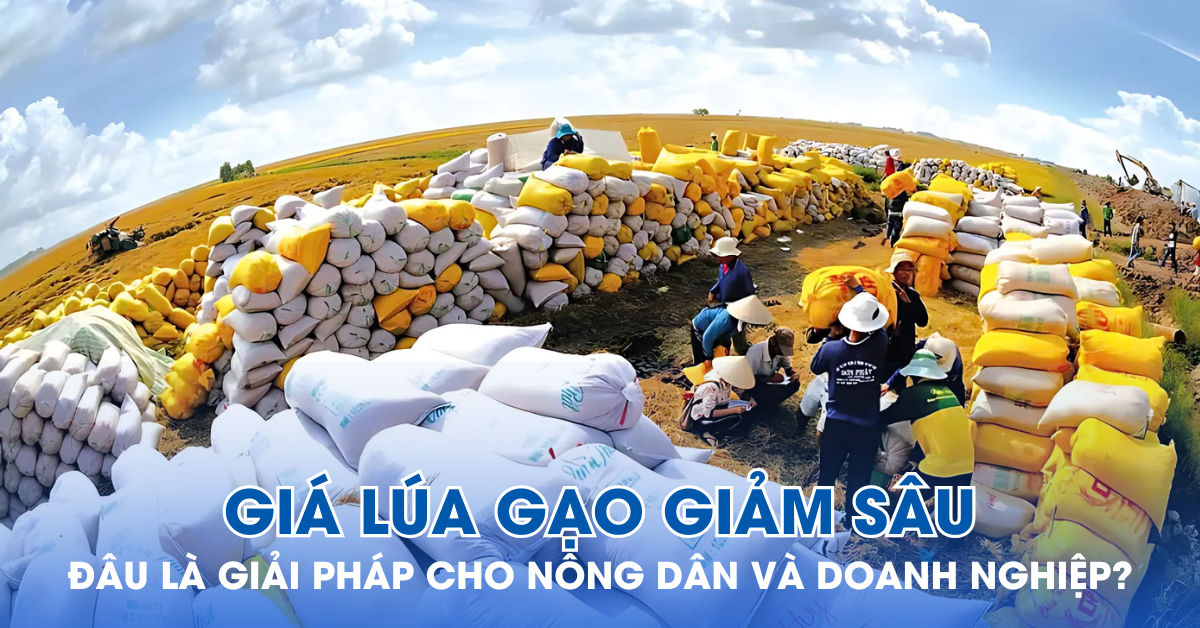Steep Rice Price Decline: What Are The Solutions For Farmers And Businesses?
24 Mar 2025

The sharp decline in rice prices in early 2025 has put significant pressure on farmers and businesses. The Ministry of Agriculture and Environment has intervened, collaborating with relevant ministries and sectors to regulate rice purchasing and exports, ensuring fair competition.
Cautious traders and businesses amidst plunging rice prices
In early 2025, Vietnam's rice market faced significant fluctuations as rice prices continued to drop. The primary reasons include abundant supply, reduced import demand, and fierce competition from major exporting countries like Thailand, India, and Pakistan. Currently, Vietnam’s 5% broken rice is priced at $389 per ton, significantly lower than Thailand’s $412 per ton and India’s $405 per ton. This has created substantial difficulties for both farmers and businesses, with profits shrinking.
In the Mekong Delta, Vietnam’s largest rice-producing region, the price of fresh IR50404 rice ranges from 5,500 to 5,700 VND/kg, showing a slight increase from the previous month but still significantly lower than the same period last year. Meanwhile, OM18 rice has dropped by 10%, now priced at 6,300 to 6,600 VND/kg. Many farmers hesitate to harvest their crops due to low prices, while traders are reluctant to place deposits.
Causes behind the sharp decline in rice prices
One of the main reasons for the price drop is the global increase in rice supply, especially after India lifted its export ban, flooding the international market with rice. This has intensified competition, making importers more cautious when signing new contracts.
Additionally, Vietnamese rice export businesses are struggling with credit access, preventing them from purchasing rice as in previous years. As a result, many traders have been forced to cancel contracts, leading to ripe rice remaining unharvested. Some rice warehouses, after milling, had no choice but to sell off their stock at low prices, further depressing the market.
Impact of the rice price decline
The falling rice prices are not only affecting farmers but also negatively impacting the entire rice industry.
Many farmers are delaying harvests due to low prices, and at times, traders have abandoned contracts, refusing to purchase rice as they cannot resell it profitably. Meanwhile, export businesses struggle to secure new contracts, as Vietnamese rice, despite being cheaper, still struggles to compete with major players like Thailand and India.
If this situation persists, farmers may reduce rice cultivation areas due to losses, affecting future supply. This underscores the need for timely government intervention to stabilize the market.
Solutions to stabilize rice prices
Strengthening market oversight to prevent price manipulation
To prevent farmers from being exploited, the Ministry of Agriculture and Environment has established inter-ministerial inspection teams to closely monitor rice purchasing and export activities. The goal is to create a fair competitive environment and prevent large enterprises from manipulating the market.
Financial support for businesses and farmers
One of the biggest challenges is limited access to credit. To address this, the State Bank of Vietnam is considering expanding loan limits and extending repayment periods for businesses purchasing rice. Additionally, interest rate support policies are being proposed to ensure businesses have sufficient capital to buy rice and stabilize the market.
Furthermore, the government is considering increasing national rice reserves to temporarily ease supply pressure and prevent excessive price drops.
Expanding export markets to reduce dependence on specific countries
To mitigate competition in traditional markets, the Ministry of Industry and Trade is actively negotiating to expand rice exports to the Middle East, Africa, and Europe. Moreover, developing Vietnam’s rice brand to increase product value is also a crucial strategy.
Minister of Agriculture and Environment Đỗ Đức Duy emphasized that relying solely on raw rice exports puts Vietnam at a disadvantage in global competition. Thus, transitioning to value-added products such as organic rice and branded packaged rice is a long-term strategy to enhance value and secure market stability.
Rice export forecast and market outlook for 2025
Rice export forecast and market outlook for 2025. Source: Internet.
According to projections, Vietnam is expected to export approximately 4.53 million tons of rice in the first half of 2025, while the second half is estimated to reach 3.012 million tons. To achieve this target, closely monitoring market trends and implementing strategic purchasing plans for reserves is essential.
The government is also requiring strict monitoring of supply and demand, ensuring uninterrupted production and preventing market manipulation. If these solutions are effectively implemented, Vietnam’s rice market will gradually stabilize, providing security for farmers and improving competitiveness for exporters.
The sharp decline in rice prices in early 2025 has significantly impacted both farmers and exporters. To address this, enhanced purchasing oversight, financial support, and market expansion are being aggressively implemented.
Despite ongoing challenges, if policies are effectively enforced, rice prices will soon stabilize, ensuring farmers’ livelihoods and maintaining Vietnam’s position in the global rice market.
Views
1038
